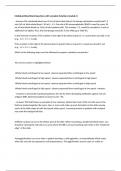Exam (elaborations)
MediaLab Blood Bank Questions with complete Solutions Graded A+
- Course
- Institution
MediaLab Blood Bank Questions with complete Solutions Graded A+ - Answers The calculated bleed was 45 mL of fetal whole blood, the dosage calculations would yield 1.5 vials (45 mL fetal whole blood / 30 mL) = 1.5. One vial of Rh immunoglobulin (RhIG) is used for every 30 mL of fetal whole blood (o...
[Show more]



